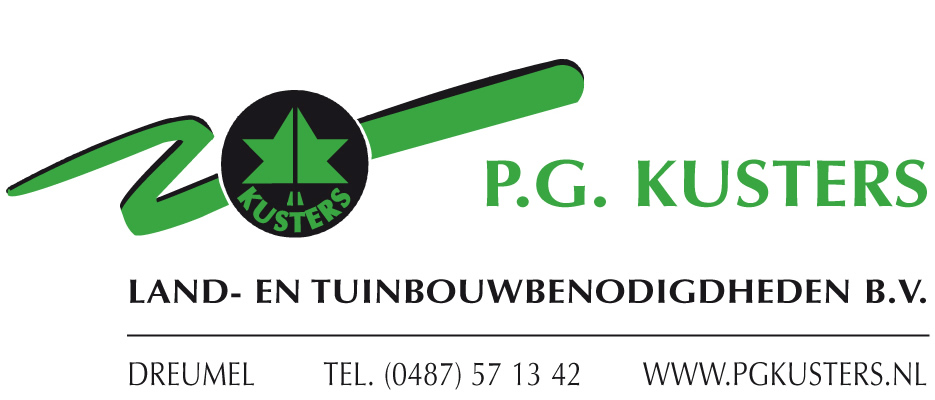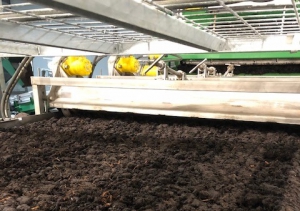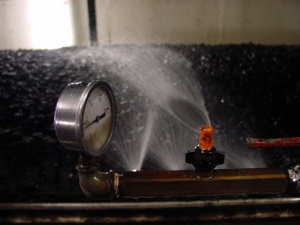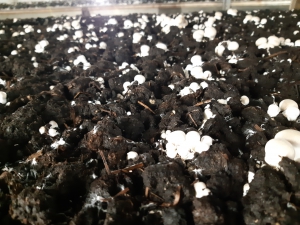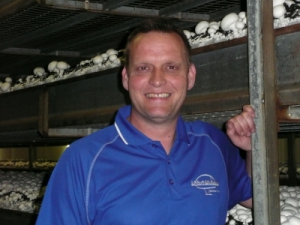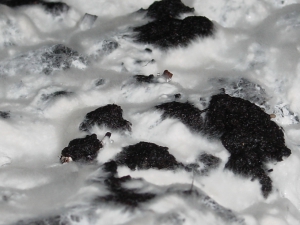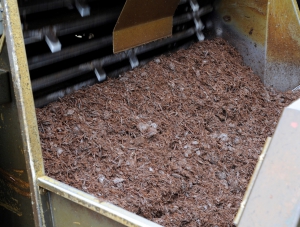Importance of filling
Many times when I see growing operations I got questions on how to get improvements and many times it always comes back to the way the room is filled. When at filling there is not enough knowledge or attention to details it will affect the rest of the growing cycle. Lets highlight some of those details.
The amount of caccing is very important to get an even growth of the mycelium into all the room but is not so easy as it sounds. Only when the compost layer comes perfectly even out of the head filling machine before the casing falls on top it is possible to get the job done with the first spinner on the machine, the spinner that is used to get caccing in the casing and spread the casing evenly. In many occasions I don’t see the even compost layer and therefore we have to go back to the other side of the machine to see what is causing the problem. It can be an uneven supply of the compost, the swivel belt timing or not enough and uneven compression. Makes sure to solve that before setting the caccing depth. Also, make sure to get an even amount of supply into the casing hopper, if not too much casing will get pushed through on moments cause more casing on those spots, so an uneven caccing there. Depending on the structure of the casing and the desired structure you can adjust the speed of the spinner to get the right result.
After the first spinner there is the next spinner with the purpose of leveling the casing. Depending on the structure of the casing adjust the speed again and make sure to set the spinner not too deep. When that spinner goes to deep and there will built up more casing behind the spinner what will happen is that it will throw casing over the spinner causing an uneven casing layer. The casing layer should have the right and even level required after the spinner before it goes under the press at the end.
Use the press for the final touch, press the casing slightly at the end of the machine, just enough to push down the last loose casing on the top but not so much that it causes anaerobic spots on top. If the level is not good enough with the 2nd spinner, the press will press too much casing and just causing anaerobic spots of casing on top of the beds where no mycelium will grow in. Minimize that as much as possible.
Setting the machine in the morning is very important. I would always start the machine on the 2nd shelf, set it up as required and try not to change too much during the rest of the room. The most critical in that is to set the right compost height in the morning to avoid too many changes. Of course we always need to adjust if necessary but make sure then to minimize the changes and if you have to adjust, adjust all the settings. A change of compost height might change the compost press, height of the spinners and casing press roll. In practice that gets forgotten and causing a different fill after the compost height is changed.
A good filling is a head start of every growing room. I just highlighted a few details that need attention but there are many more of course. It’s not so easy to get the room filled exactly as required but good training and of course good equipment will get the job done and make the rest of the cycle easier to get the maximum result.
Erik de Groot
This email address is being protected from spambots. You need JavaScript enabled to view it.
If one wants to start a discussion with a grower (or with a consultant), start talking about watering.
How much, when and what watering method.
To make any sense though, you first have to define the period. There is watering on casing soil and watering over mushrooms and between flushes.
This blog is about watering on the casing soil during the incubation period. The water given in that period is to bring the casing soil up to the maximum moisture level and to keep the compost at the right moisture.
A good phase 3 compost at the moment of casing will be around 60% in moisture. For white strains that can be up to 3% higher, brown strains prefer 1 or 2% drier. It is not possible to bring the compost to a much higher moisture level by watering it after filling. It is possible to give water into the compost but that will be free water which has to disappear during the fructification period.
2 up to 4 litres of water can be given into the compost at filling or later but that should be the maximum. Even if it is necessary to cool the compost. This can better be done by giving water into the casing and let it evaporate with fresh air and circulation.
Casing soil itself can handle up to 7 litres per m² plus the water that was originally in the casing. To be sure, we talk about a casing containing white and black peat.
More than 7 litres will evaporate, go into the compost or down the drain.
Considering that the evaporation can be around 2 litres per m² per day, the loss with evaporation is about 10 litres. If you count the loss of dripping, the water staying in the compost and the evaporation you come to a figure of about 25 litres of water. In practical situations this means a total amount of water between 20 and 30 litres average. Depending on the farm and the time of the year. Growing drier often means a loss of production and growing a lot wetter means problems in growing, mainly in the outgrow of mushrooms.
Another thing to watch for is the watering method. Make sure that the pressure of the water onto the casing is not too high. Too many times I see a casing with a damaged surface which will give problems in the evaporation.
Every system has a different pressure and if you are not sure, ask the manufacturer. Regularly cleaning of the nozzles is something will help maintaining the right pressure and the right adjustment of the watering trees, looking at distance and height according to the casing level.
Keep watering but do not take it over the top!!
An appropriate title for a blog written on Easter Monday.
Normally the 7th day is a day of rest. Good for people after a week of working but not always good if mushrooms take a rest. Read: they stop growing. This can happen during the fructification and if the reaction of the grower is too slow, the flush grows out to be too small.
Fructification is split into two sections. 4 to 5 days for making the mushrooms or forming the primordia. The second part is roughly from day 5 till the start of the first flush. During the first part RH, ambient temperature and CO2 are the main parameters to control the number of primordia. Compost temperature is for me not that important at that time. After day 5 the RH is lowered to let the primordia grow out to be mushrooms. The CO2 is dropped slowly and we also start dropping the temperature to reach 17.5° C ambient temperature at the start of the flush (my favourite temperature to work with).
On day 7 one can see mushrooms developing in the size of 2 to 5 millimetres. And then this phenomenon can occur. You look during your morning check and everything looks good. The next day, nothing has happened. General reaction is waiting. But if you look carefully, in most of the cases the room is not taking enough fresh air. CO2 is okay, RH is okay, air temperature is okay and the compost temperature is declining. If the minimum fresh air setting is too low, the room can have a lack of oxygen and mushrooms just stop developing. Simplest thing to do is to drop the CO2 setting to 800 ppm for a couple of hours. To avoid this however and the best way to handle this, is to make sure that the minimum fresh air setting is around 25%. Then the climate unit will always use enough fresh air and mushrooms keep growing. By the way, this happens mostly with strains which tend to give bigger mushrooms. Because they already tend to give fewer mushrooms.
Using steam for humidifying
In many systems steam is used for humidifying the grow rooms. It’s a good solution to keep the right climate in the grow rooms but just keep the amount of steam going into the grow room under control. Let me explain what I mean by that.
Especially on the moment just after cool down we get a lot of steam in the grow rooms for humidity to keep the right, set humidity level. That also brings in a lot more heat in the room and especially in summer period that will give extra demand on your cooling. After some time, you will see in the computer that not only the steam valve will keep opening but the cooling as well, one will bring in humidity, the other will bring it down. The result is loss of energy and not a pleasant climate in the room with a RH level variating from very high too low, due to a lot of steam used by the climate control unit. It will be more visible under the air bags, where the steam comes out, and the RH on the growing surface will be higher. The mycelium will continue to grow there, if you compare it with the rest of the room, and less pins will grow out on those spots.
By simply wetting the floor the first 3 days after cool down you can minimize the steam by bringing in the extra moisture with the wet floors. You can do that 3 times/day if needed. Watch the steam demand in your climate computer and that will tell you if you need to wet the floor.
Erik de Groot
This email address is being protected from spambots. You need JavaScript enabled to view it.
High, higher, too high?
After the last water during the incubation in the casing soil, the grower wants the mycelium to grow onto the surface.
To ensure a good recovery of the mycelium in this period the right settings for the room climate are essential.
An RH at a minimum of 95%. A very slow air speed, if possible zero and an adequate room temperature. That room temperature should be as close to the optimum for vegetative growth as possible. That optimum temperature is 25° C to 26° C.
This means often a room temperature of around 21° as a minimum.
Then the mycelium has the right conditions to grow onto the surface.
The next question is: how high do I let it grow ?
Higher means better control of the number of primordia, so no surprises about the number of mushrooms growing out. Higher also means easier picking so a higher pick rate. Another positive experience is that clustering is easier avoided.
But the big dis-advantage of having the mycelium higher on the surface is that the climate conditions have to be perfect. The influence of the climate onto the mycelium and the primordia is bigger. So one moment of for instance too low RH means that you will lose primordia.
Deeper mycelium is also easier to stagger the mushrooms so that is an advantage too. Another point is the fact if the grower can stop the mycelium when it grows too high. Overlay as that is called makes the outgrow of primordia more difficult. They come from underneath the blanket of mycelium.
So what determines the choice?
Both ways have their pro’s and con’s.
But for me the crucial point to choose a way is the technical capacity of the farm and the experience of the grower. If you are able to stop the mycelium at all times, still create the stagger and have perfect control of the environmental conditions, grow white.
If you are not sure of all this, grow deeper into the surface of the casing soil. So grow blacker.
Generally blacker is safer.
Higher Filling
Does a higher filling weight give better quality?
The filling weight, i.e. the number of kilos of compost per square metre, should be between 80-95 kg/m2. The general trend is the more compost, the better the mushroom quality. But is that right?
Mushroom growing is all about the difference between air temperature and compost temperature, referred to by growers as activity. Activity is essential to grow good quality mushrooms. As the compost is warmer than the air, moisture is released in the form of evaporation. This caused the mushrooms to grow.
Managing activity
Managing activity is key to mushroom growing. So too much activity, because the filling weight is too high, results in faster, uncontrollable growth. For example, a first flush that produces 8 to 10 kg/m2 of mushrooms on the third day. The quality has been lost. The compost temperature has risen too quickly to 25-26 degrees Celsius. So any added value of filling that extra kilo of compost has been wasted. Say you had filled 90 kg/m2 of compost. In that case a filling weight of 85 kg/m2 would have been a better choice. This makes it easier to manage and control activity.
Casing soil
The casing soil on the compost plays a significant role here. The more activity there is, the more the casing soil dehydrates. This means that more mycelium grows in the casing soil. Dried out casing soil cannot absorb water, and neither can mycelium. What is left is dry casing soil that disrupts the water transport from the compost to the mushrooms. The casing soil effectively acts as insulation blanket. So there is activity, but little growth.
Best production
I see the highest yields and the best quality, from the first to the third flush, in situations where compost activity is well managed and controlled and the casing soil stays soft and wet.
Mark den Ouden
NEW: Live training Mushroom Signals Essentials
Live training combined with e-learning. E-learning offers the basics, leaving more time for individual questions and farm visits during live training!
Organised by Mushroom Office: Mushroom Signals Essentials live training 8-12 June 2020.



